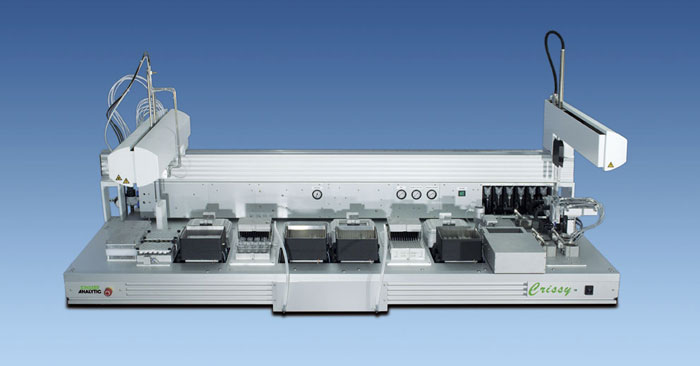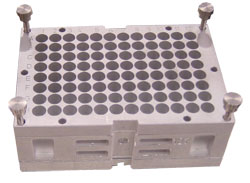Crissy ® Automated Liquid Handling Platform
Preformulation Research System


Polymorphism has become a concern in today’s pharmaceutical research laboratories as it affects a number of issues in pharmaceutical systems varying from processing characteristics to bioavailability. During the pre-formulation stage of drug development, polymorph screening is a tedious and time-consuming process.
Zinsser Analytic has developed CRISSY, an automated liquid and powder handling platform for salt pre-screening and polymorph screening studies. This platform automates the necessary steps for extensive crystallization using different solvents, temperatures, concentrations, agitation and pH-measurement. A special CRISSY® reactor block has been designed to directly present the crystals to the XRPD system without any additional sampling steps. The surface of the reactor base is ideal for XRPD-detection. Cross contamination caused by electrostatic force from moving the powders is minimized as the detector block itself is grounded and the individual reactor cavities are separated from each other in the “up” position.
Proven reliable X,Y,Z-platform with 4 independent Z-drives for liquid and powder handling and an integrated robotic arm for gripping vials, tubes, plates and pick-up tools, which can then be placed in any position of the workbench area.
Unique new hardware approach The precision balance is positioned outside the workbench still within reach of the robotic arm. The balance stand avoids any mechanical distortion, minimizing the settling time, improving the sensitivity and therefore increasing the throughput.
Designed for customization To meet individual requirements, it can be equipped with vortexers, hotplates, cooling plates, stirrers, reactor blocks, incubators or other modules from our extensive range of tools. The unique software allows the customer to even integrate his own modules. For special applications we offer the service of integration of custom modules.
For Crissy a special reactor system has been developed. The reactor consists of an aluminum carrier with 96 PTFE-inserts (reusable and cleanable in an ultra sonic bath) and adjustable bases with a glass disc on top.

The reactors can be sealed with the seals and sandwich plates of the “DESYRE®”-reactor system. The ELAS®-mat or SILTEF®-mat (PTFE coated) with 96 cross-slitted sealing rings are highly recommended as the first seal on top of the reaction cavities. An aluminum top plate secures the cross-slitted "dimplemats", hold down by thumbscrews for easy opening and closing. If necessary, further sealing layers can be added, also an inert gas shield can be added. For long term incubation – where the pierced sealing mats may cause evaporation of the solvents in the reactors – a solid seal can replace the septum seals. Crissy® reactors are also available for automatic sealing, an automatic lidding station can be provided as an option.|
For long reaction times it also may be advisable to take the reactor blocks off the platform and let them incubate on external DESYRE®-Mix hotplate vortexers to save valuable space on the automatic workbench.
The glass disc of the reactor base is ideal for XRPD-detection. The Crissy®-reactor can be directly presented to the XRPD system without any additional sampling steps. Cross contamination caused by electrostatic force from moving the powders, is minimized as the detector block itself is grounded and the individual reactor cavities are isolated in the “up”- position from each other.
Options for outstanding flexibility The open design of the Crissy platform and the Zinsser Software allow the integration of a number of modules to optimize the functions of Crissy for individual applications.
Crissy can import Excel®-sheets with the sample volumes and weights to run the experiment methods. Sample information (position, volumes, weights etc.) can also be exported in Excel-or any other format at the end of the run to peripheral systems or networks. The software helps to plan the experiments and organizes the weighing and liquid distribution of the sample materials, reagents and solvents.
Crystallization
The dry sample powders are weighed individually with the PickFix® or Varix®-tool, with or without a weigh-check. Reagents are added with the 2-channel filtration probe – for sensitive or reactive studies - together with inert gas through the 2nd channel. The probe will penetrate the top cross-slitted septum, which re-seals extremely well, when the probe is retracted. For incubation and mixing the Crissy®-reactor is transferred to one of the DESYRE®-Mix vortexers for heating or cooling. During vortexing the reactor is securely clamped to the top plate of the vortexer. For filtration the center channel will slowly aspirate the solution while traveling downwards. The solution will be transferred to and collected in a deep well plate.
The mother liquid can be selected with the filtration tip and will be transferred into a 96-well filtration plate, placed on a vacuum box with a receiving plate or HPLC vials. The receiving plate can be stored on a cooled position at +4 or +8 °C, which is connected to an external chiller. To assure a particle free solution for analysis, the mother liquid can be collected in a 96-well filtration plate. With vacuum and/or positive pressure the samples can be filtered on the filtration station into 96-well receiving plates. These can be automatically taken out of the filtration box and placed on the cooling plate to avoid evaporation of sample.